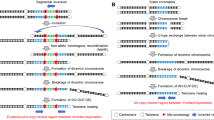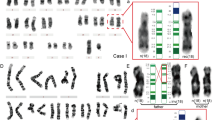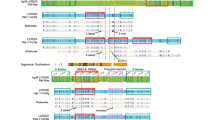Abstract
Smith–Magenis syndrome (SMS), caused by del(17)p11.2, represents one of the most frequently observed human microdeletion syndromes. We have identified three copies of a low–copy–number repeat (SMS–REPs) located within and flanking the SMS common deletion region and show that SMS–REP represents a repeated gene cluster. We have isolated a corresponding cDNA clone that identifies a novel junction fragment from 29 unrelated SMS patients and a different–sized junction fragment from a patient with dup(17)p11.2. Our results suggest that homologous recombination of a flanking repeat gene cluster is a mechanism for this common microdeletion syndrome.
This is a preview of subscription content, access via your institution
Access options
Subscribe to this journal
Receive 12 print issues and online access
$209.00 per year
only $17.42 per issue
Buy this article
- Purchase on Springer Link
- Instant access to full article PDF
Prices may be subject to local taxes which are calculated during checkout
Similar content being viewed by others
References
Krawczak, M. & Cooper, D.N. Gene deletions causing human genetic disease: mechanisms of mutagenesis and the role of the local DNA sequence environment. Hum. Genet. 86, 425–441 (1991).
Peeters, B.P.H., de Boer, J.H., Bron, S. & Venema, G. Structural plasmid instability in Bacillus subtilis: effect of direct and inverted repeats. Mol. Gen. Genet. 212, 450–458 (1988).
Singer, B.S. & Westlye, J. Deletion formation in bacteriophage T4. J. Mol. Biol. 202, 233–243 (1988).
Whoriskey, S.K., Schofield, M.A. & Miller, J.H. Isolation and characterization of Escherichia coli mutants with altered rates of deletion formation. Genetics 127, 21–30 (1991).
Greenberg, F. et al. Molecular analysis of the Smith-Magenis syndrome: a possible contiguous-gene syndrome associated with del(17)(p11.2). Am. J. Hum. Genet. 49, 1207–1218 (1991).
Smith, A.C.M. et al. Interstitial deletion of (17)(p11.2p11.2) in nine patients. Am. J. Med. Genet. 24, 393–414 (1986).
Stratton, R.F. et al. Interstitial deletion of (17)(p11.2p11.2): report of six additional patients with a new chromosome deletion syndrome. Am. J. Med. Genet. 24, 421–432 (1986).
Greenberg, F. et al. Multi-disciplinary clinical study of Smith-Magenis syndrome (deletion 17p11.2). Am. J. Med. Genet. 62, 247–254 (1996).
Chen, K.-S., Potocki, L. & Lupski, J.R. Smith-Magenis syndrome [del(17)p11.2]: clinical review and molecular advances. Ment. Retard. Dev. Disabil. Res. Rev. 2, 122–129 (1996).
Guzzetta, V. et al. Somatic cell hybrids, sequence-tagged sites, simple repeat polymorphisms, and yeast artificial chromosomes for physical and genetic mapping of proximal 17p. Genomics 13, 551–559 (1992).
Juyal, R.C. et al. Molecular analyses of 17p11.2 deletions in 62 Smith-Magenis syndrome patients. Am. J. Hum. Genet. 58, 998–1007 (1996).
Trask, B.J. et al. Quantification by flow cytometry of chromosome-17 deletions in Smith-Magenis syndrome patients. Hum. Genet. 98, 710–718 (1996).
Ledbetter, D.H. & Ballabio, A. Molecular cytogenetics of contiguous gene syndromes: mechanisms and consequences of gene dosage imbalance. in The Metabolic and Molecular Bases of Inherited Disease, 7th Ed., Vol. 1 (eds Scriver, C.R., Beaudet, A.L, Sly, W.S. & Valle, D.) 811–839 (McGraw-Hill, New York, (1995).
Guzzetta, V., Montes de Oca-Luna, R., Lupski, J.R. & Patel, P.I. Isolation of region-specific and polymorphic markers from chromosome 17 by restricted Alu polymerase chain reaction. Genomics 9, 31–36 (1991).
Bellanné-Chantelot, C. et al. Mapping the whole human genome by fingerprinting yeast artificial chromosomes. Cell 70, 1059–1068 (1992).
Albertsen, H.M. et al. Construction and characterization of a yeast artificial chromosome library containing seven haploid human genome equivalents. Proc. Natl. Acad. Sci. USA 87, 4256–4260 (1990).
Murray, J.C. et al. A comprehensive human linkage map with centimorgan density. Science 265, 2049–2054 (1994).
Green, E.D. & Olson, M.V. Systematic screening of yeast artificial-chromosome libraries by use of the polymerase chain reaction. Proc. Natl. Acad. Sci. USA 87, 1213–1217 (1990).
Kwiatkowski, T.J.J., Zoghbi, H.Y., Ledbetter, S.A., Ellison, K.A. & Chinault, A.C. Rapid identification of yeast artificial chromosome clones by matrix pooling and crude lysate PCR. Nucleic Acids Res. 18, 7191–7192 (1990).
Chumakov, I.M. et al. Isolation of chromosome 21-specific yeast artificial chromosomes from a total human genome library. Nature Genet. 1, 222–225 (1992).
Chumakov, I. et al. Continuum of overlapping clones spanning the entire human chromosome 21q. Nature 359, 380–387 (1992).
Herz, J., Flint, N., Stanley, K., Frank, R. & Dobberstein, B. The 68 kDa protein of signal recognition particle contains a glycine-rich region also found in certain RNA-binding proteins. FEBS Lett. 276, 103–107 (1990).
Nakamura, T. et al. A novel transcriptional unit of the tre oncogene widely expressed in human cancer cells. Oncogene 7, 733–741 (1992).
Chevillard, C. et al. Relationship between Charcot-Marie-Tooth 1A and Smith-Magenis regions: snU3 may be a candidate gene for the Smith-Magenis syndrome. Hum. Mol. Genet. 2, 1235–1243 (1993).
Kallioniemi, O.-P. et al. Physical mapping of chromosome 17 cosmids by fluorescence in situ hybridization and digital image analysis. Genomics 20, 125–128 (1994).
Lee, C.C. et al. Isolation of chromosome-specific genes by reciprocal probing of arrayed cDNA and cosmid libraries. Hum. Mol. Genet. 8, 1373–1380 (1995).
de Hostos, E.L., Bradtke, B., Lottspeich, F. & Gerisch, G. Coactosin, a 17 kDa F-actin binding protein from Dictyostelium discoideum. Cell. Motil. Cytoskeleton 26, 181–191 (1993).
Wu, C., Friedlander, P., Lamoureux, C., Zannis-Hadjopoulos, M. & Price, G.B. cDNA clones contain autonomous replication activity. Biochim. Biophys. Acta 1174, 241–257 (1993).
Shaffer, L.G., Kennedy, G.M., Spikes, A.S. & Lupski, J.R. Diagnosis of CMT1A duplications and HNPP deletions by interphase FISH: implications for testing in the cytogenetics laboratory. Am. J. Med. Genet. 69, 325–331 (1997).
Scheurlen, W.G. et al. High-resolution deletion mapping of chromosome arm 17p in childhood primitive neuroectodermal tumors reveals a common chromosomal disruption within the Smith-Magenis region, an unstable region in chromosome band 17p11.2. Genes Chromosomes Cancer 18, 50–58 (1997).
Wilgenbus, K.K. et al. Molecular characterization of a genetically unstable region containing the SMS critical area and a breakpoint cluster for human PNETs. Genomics 42, 1–10 (1997).
Lifton, R.P. et al. A chimaeric 11β-hydroxylase/aldosterone synthase gene causes glucocorticoid-remediable aldosteronism and human hypertension. Nature 355, 262–265 (1992).
Melki, J. et al. De novo and inherited deletions of the 5q13 region in spinal muscular atrophies. Science 264, 1474–1477 (1994).
Roy, N. et al. The gene for neuronal apoptosis inhibitory protein is partially deleted in individuals with spinal muscular atrophy. Cell 80, 167–178 (1995).
Lefebvre, S. et al. Identification and characterization of a spinal muscular atrophy-determining gene. Cell 80, 155–165 (1995).
Ballabio, A., Bardoni, B., Guioli, S., Basler, E. & Camerino, G. Two families of low-copy-number repeats are interspersed on Xp22. 3: implications for the high frequency of deletions in this region. Genomics 8, 263–270 (1990).
Yen, P.H. et al. Frequent deletions of the human X chromosome distal short arm result form recombination between low copy repetitive elements. Cell 61, 603–610 (1990).
Li, X.-M., Yen, P.H. & Shapiro, L.J. Characterization of a low copy repetitive element S232 involved in the generation of frequent deletions of the distal short arm of the human X chromosome. Nucleic Acids Res. 20, 1117–1122 (1992).
Nathans, J., Piantanida, T.P., Eddy, R.L., Shows, T.B. & Hogness, D.S. Molecular genetics of inherited variation in human color vision. Science 232, 203–210 (1986).
Maniatis, T., Fritsch, E.F., Lauer, J. & Lawn, R.M. The molecular genetics of human hemoglobins. Annu. Rev. Genet. 14, 145–178 (1980).
Lakich, D., Kazazian, H.H., Antonarakis, S.E. Jr., & Gitschier, J. Inversions disrupting the factor VIII gene are a common cause of severe haemophilia A. Nature Genet. 5, 236–241 (1993).
Juyal, R.C. et al. Apparent mosaicism for del(17)(p11.2) ruled out by fluorescence in situ hybridization in a Smith-Magenis syndrome patient. Am. J. Med. Genet. 59, 406–407 (1995).
Juyal, R.C. et al. Smith-Magenis syndrome deletion: a case with equivocal cytogenetic findings resolved by fluorescence in situ hybridization. Am. J. Med. Genet. 58, 286–291 (1995).
Zori, R.T. et al. Clinical, cytogenetic, and molecular evidence for an infant with Smith-Magenis syndrome born from a mother having a mosaic 17p11.2p12 deletion. Am. J. Med. Genet. 47, 504–511 (1993).
Botto, M. et al. Homozygous hereditary C3 deficiency due to a partial gene deletion. Proc. Natl. Acad. Sci. USA 89, 4957–4961 (1992).
Lehrman, M.A., Russell, D.W., Goldstein, J.L. & Brown, M.S. Alu-Alu recombination deletes splice acceptor sites and produces secreted low density lipoprotein receptor in a subject with familial hypercholesterolemia. J. Biol. Chem. 262, 3354–3361 (1987).
Kmiec, E.B., Angelides, K.J. & Holloman, W.K. Left-handed DNA and the synaptic pairing reaction promoted by Ustilago Red protein. Cell 40, 139–145 (1985).
Pentao, L., Wise, C.A., Chinault, A.C., Patel, P.I. & Lupski, J.R. Charcot-Marie-Tooth type 1A duplication appears to arise from recombination at repeat sequences flanking the 1.5 Mb monomer unit. Nature Genet. 2, 292–300 (1992).
Chance, P.F. et al. Two autosomal dominant neuropathies result from reciprocal DNA duplication/deletion of a region on chromosome 17. Hum. Mol. Genet. 3, 223–228 (1994).
Roa, B.B. & Lupski, J.R. Molecular genetics of Charcot-Marie-Tooth neuropathy, in Advances in Human Genetics, Vol. 22 (eds Harris, H. & Hirschhorn, K.) 117–152 (Plenum, New York, (1994).
Reiter, L.T. et al. A recombination hotspot responsible for two inherited peripheral neuropathies is located near a mariner transposon-like element. Nature Genet. 12, 288–297 (1996).
LeGuern, E. et al. A de novo case of hereditary neuropathy with liability to pressure palsies (HNPP) of maternal origin: a new mechanism for deletion in 17p11.2? Hum. Mol. Genet. 5, 103–106 (1996).
Jones, C. et al. Association of a chromosome deletion syndrome with a fragile site within the proto-oncogene CBL2. Nature 376, 145–149 (1995).
Roa, B.B. et al. Duplication of the PMP22 gene in 17p partial trisomy patients with Charcot-Marie-Tooth type-1 A neuropathy. Hum. Genet. 97, 642–649 (1996).
Reiter, L.T., Murakami, T., Koeuth, T., Gibbs, R.A. & Lupski, J.R. The human COX10 gene is disrupted during homologous recombination between the 24-Kb proximal and distal CMT1 A-REPs. Hum. Mol. Genet. 6, 1595–1603 (1997).
Halford, S. et al. Low-copy-number repeat sequences flank the DiGeorge/velo-cardio-facial syndrome loci at 22q11. Hum. Mol. Genet. 2, 191–196 (1993).
Ji, Y. et al. An evolutionary conserved gene associated with the common deletion breakpoint regions in the Prader-Willi/Angelman syndromes. Am. J. Hum. Genet. 59, A158 (1996).
Christian, S.L. et al. Molecular characterization of two proximal deletion breakpoint regions in both Prader-Willi and Angelman syndrome patients. Am. J. Hum. Genet. 57, 40–48 (1995).
Pérez, L.A., Peoples, R., Kaplan, P., Hamel, B.C.J. & Francke, U. Molecular definition of the chromosome 7 deletion in Williams syndrome and parent-of-origin effects on growth. Am. J. Hum. Genet. 59, 781–792 (1996).
Altschul, S.F., Gish, W., Miller, W., Myers, E.W. & Lipman, D.J. Basic local alignment search tool. J. Mol. Biol. 215, 403–410 (1990).
Evans, G.A., Lewis, K. & Rothenberg, B.E. High efficiency vectors for cosmid microcloning and genomic analysis. Gene 79, 9–20 (1989).
Brownstein, B.H. et al. Isolation of single-copy human genes from a library of yeast artificial chromosome clones. Science 244, 1348–1351 (1989).
Ochman, H., Gerber, A.S. & Hartl, D.L. Genetic applications of an inverse polymerase chain reaction. Genetics 120, 621–623 (1988).
Silverman, G.A. et al. Yeast artificial chromosome cloning of a two-megabase-size contig within chromosomal band 18q21 establishes physical linkage between BCL2 and plasminogen activator inhibitor type-2. Genomics 9, 219–228 (1991).
Feinberg, A.P. & Vogelstein, B. A technique for radiolabeling DNA restriction endonuclease fragments to high specific activity.Anal. Biochem. 132, 6–13 (1983).
Chen, K.-S. et al. The human homologue of the Drosophila melanogasterflightless-I gene (fill) maps within the Smith-Magenis microdeletion critical region in 17p11.2. Am. J. Hum. Genet. 56, 175–182 (1995).
van Tuinen, P., Rich, D.C., Summers, K.M. & Ledbetter, D.H. Regional mapping panel for human chromosome 17: application to neurofibromatosis type 1. Genomics 1, 374–381 (1987).
Elder, F.F.B., Nichols, M.M., Hood, O.J. & Harrison, W.R. III.Unbalanced translocation (15;17)(q13;p13.3) with apparent Prader-Willi syndrome but without Miller-Dieker syndrome. Am. J. Med. Genet. 20, 519–524 (1985).
Roa, B.B. et al. Evidence for a recessive PMP22 point mutation in Charcot-Marie-Tooth disease type 1 A. Nature Genet. 5, 189–194 (1993).
Gyapay, G. et al. The 1993-94 Genethon human genetic linkage map. Nature Genet. 7, 246–249 (1994).
Matise, T.C., Perlin, M. & Chakravarti, A. Automated construction of genetic linkage maps using an expert system (MultiMap): a human genome linkage map. Nature Genet. 6, 384–390 (1994).
Weissenbach, J. et al. A second-generation linkage map of the human genome. Nature 359, 794–801 (1992).
Buetow, K.H. et al. Human genetic map; genome maps V: wall chart. Science 265, 2055–2070 (1994).
Townsend-Nicholson, A., Baker, E., Sutherland, G.R. & Schofield, P.R. Localization of the adenosine A2b receptor subtype gene (ADORA2B) to chromosome 17p11.2-p12 by FISH and PCR screening of somatic cell hybrids. Genomics 25, 605–607 (1995).
Hua, X., Wu, J., Goldstein, J.L., Brown, M.S. & Hobbs, H.H. Structure of the human gene encoding sterol regulatory element binding protein-1 (SREBF1) and localization of SREBFl and SREBF2 to chromosomes 17p11.2 and 22q13. Genomics 25, 667–673 (1995).
Campbell, H.D. et al. Genomic structure, evolution, and expression of human FLU, a gelsolin and leucine-rich-repeat family member: overlap with LLGL. Genomics 42, 46–54 (1997).
Koyama, K. et al. The human homologue of the murine Llglh gene (LLGL) maps within the Smith-Magenis syndrome region in 17p11.2. Cytogenet. Cell Genet. 72, 78–82 (1996).
Elsea, S.H. et al. Haploinsufficiency of cytosolic serine hydroxymethyltransferase in the Smith-Magenis syndrome. Am. J. Hum. Genet. 57, 1342–1350 (1995).
Zhao, Z. et al. The gene for a human microfibril-associated glycoprotein is commonly deleted in Smith-Magenis syndrome patients. Hum. Mol. Genet. 4, 589–597 (1995).
Matsuda, Y. et al. Chromosome mapping of human (ZNF179), mouse, and rat genes for brain finger protein (bfp), a member of the RING finger family. Genomics 33, 325–327 (1996).
Kimura, T. et al. The brain finger protein gene (ZNF179), a member of the RING finger family, maps within the Smith-Magenis syndrome region at 17p11.2. Am. J. Med. Genet. 69, 320–324 (1997).
Hiraoka, L.R., Hsu, L. & Hsieh, C.-L. Assignment of ALDH3 to human chromosome 17p11.2 and ALDH5 to human chromosome 9p13. Genomics 25, 323–325 (1995).
De Laurenzi, V. et al. Sjögren-Larsson syndrome is caused by mutations in the fatty aldehyde dehydrogenase gene. Nature Genet. 12, 52–57 (1996).
Author information
Authors and Affiliations
Corresponding author
Rights and permissions
About this article
Cite this article
Chen, KS., Manian, P., Koeuth, T. et al. Homologous recombination of a flanking repeat gene cluster is a mechanism for a common contiguous gene deletion syndrome. Nat Genet 17, 154–163 (1997). https://doi.org/10.1038/ng1097-154
Received:
Accepted:
Issue Date:
DOI: https://doi.org/10.1038/ng1097-154
This article is cited by
-
The behavioural phenotype of Potocki-Lupski syndrome: a cross-syndrome comparison
Journal of Neurodevelopmental Disorders (2018)
-
Heterogeneous rates of genome rearrangement contributed to the disparity of species richness in Ascomycota
BMC Genomics (2018)
-
Important Roles of Ring Finger Protein 112 in Embryonic Vascular Development and Brain Functions
Molecular Neurobiology (2017)
-
Smith-Magenis Syndrome: Face Speaks
The Indian Journal of Pediatrics (2016)
-
Nonrecurrent PMP22-RAI1 contiguous gene deletions arise from replication-based mechanisms and result in Smith–Magenis syndrome with evident peripheral neuropathy
Human Genetics (2016)



